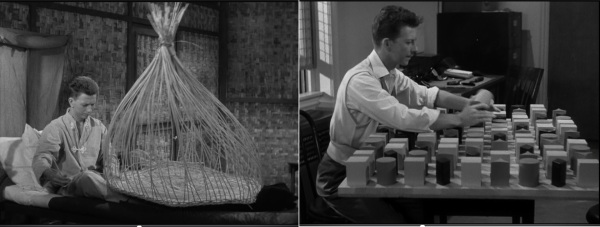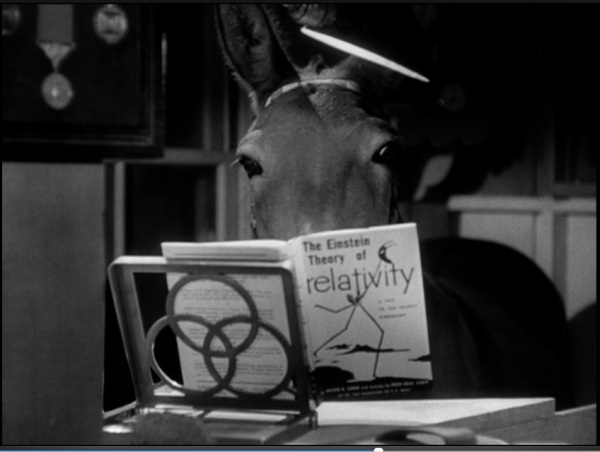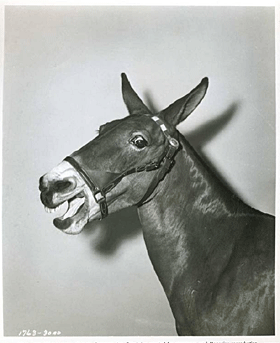Having recently seen all seven Francis the Talking Mule films, I think I can state with some authority that mules are not the most expressive of animals. They lack the emotional range of dogs; they haven’t the poetic nobility of horses nor the charm and animation of dolphins; nor do they possess that singular attitude of cats, an aloof serenity that gives them the grandeur of gods.
No, mules tend just to stand there. Occasionally they might prick up their ears and look tolerably interested if something of interest is offered to them (carrots, say), but in the main they assume the expression of what P.G. Wodehouse called a stuffed frog. It can’t be easy to make a mule look lively. Just take a gander at that hee-hawing mule image on the Francis DVD box. It looks more like a squashed woman’s shoe with a dangling heel than anything mammalian. The challenge for a film director would be to make a mule look good on camera—to endow that long, flat, furry visage with life and feeling, something audiences can look at, respond to, feel empathy for. In effect, to give a mule a face.
Look, I’m not knocking mules. They’re fine, upstanding members of the animal kingdom. If I had to choose a trusty four-footed companion for a long walking tour, Lassie or Rin Tin Tin might be first, but Francis would be a definite second. And in equus asinus’s defense, I did find Francis’s physical portrayer in the series appealing. While Francis-with-an-I is male (and he gets pretty ticked off if you think otherwise), he was acted in all seven Universal films—Francis (the Talking Mule); Francis Goes to the Races; Goes to West Point; Covers the Big Town; Joins the WACS; in the Navy; in the Haunted House—by a female mule named Molly. Molly was small and well shaped, and had large, dark, mild eyes with the kind of long, curly lashes that glamour gals kill for. By all accounts she was a sweet-tempered creature, whose docility and easy handling led to her casting. There’s nothing threatening about Molly, and I’ve no doubt that young and old, and even a wary blogger or two, would adore her and feel safe in her presence.
Though there’s little that’s sweet or mild about Francis himself. He’s an ornery old cuss, sarcastic, cynical, downright cranky. A bit like William Demarest on hooves. Chill Wills, who supplied Francis’s voice in the first six films, has the right braying timbre, drawling out his lines in long, quavery slides, like a bassoon imitating a trombone, whenever Francis sneers (and that’s often) at the inferior intelligence of homo sapiens. His mulish scorn is mostly directed at his human sidekick, Peter Stirling, played by poor Donald O’Connor, who may have been the most unfortunate straight man since Zeppo Marx. Watching O’Connor interact with his four-legged co-star, I was reminded of that old show-biz warning about never acting with children or animals. Let’s face it: in scenes involving a talking mule, who ya gonna watch? Being upstaged by a flop-eared quadruped is not what I’d call career-enhancing.
I marvel at O’Connor’s mule-like endurance (in six films, ye gods!), in a part that in no way stretched his abilities (or maybe it was an iron-clad Universal contract, which must have clasped him as tightly as an Iron Maiden). From film to film, Peter’s character never changes—an unvaried innocent, child-like, sexless, naive. He never wises up or figures out how the world works (and he almost never kisses the girl). The plots, revolving around stock mysteries, usually in the military (Francis; West Point; WACS; Navy), but also in horse racing (Races) and journalism (Big Town), follow a simple template: Francis gives advice and information to Peter (with the air of one extending an immense favor), and then, when Peter is forced to admit his informant is Francis (“a mule,” he adds, almost offhandedly), must pull him out of the soup. Almost each film ends with Francis revealing his talking abilities to humanity at large, something you’d think would cause a bit of a stir, but the memory of which is never carried over to the next sequel.

The perils of admitting to a four-legged best friend: Peter finds himself weaving baskets or fitting blocks, at psychiatric behest.
The series seemed geared toward children; there’s little violence and no sex. But its narrative hook, basically that of a schnooky guy who can’t function as a grown-up without the help of a smartass mule, is a thin premise to drag over seven entries. The series loses air like a deflating balloon: by the fourth film (Big Town), its tired story feels as quavery as one of Chill Wills’s long notes; and the sixth film (Navy), with a mistaken-identity plot no one seems able to muster enough oxygen to get across, is pretty dire. Dissension had also reared in the ranks: director Arthur Lubin complained of being typecast as “an animal director,” and O’Connor made the sixth film only for a “financial inducement” and at his daughter’s request.
So, I wonder why the series was so successful (I’m not even counting Francis’s later incarnations in cartoons and comic books). No doubt, audiences like talking animals. There’s something both enchanting and homey about vocalizing vertebrates. Anyone with a pet knows that furry companions already can communicate; adding speech is a mere matter of clarification. And perhaps parents desperate for entertainment that won’t alarm or corrupt the kiddies view speechifying species-other-than-humans as child-safe fare (it’s the foundation of Disney’s popularity). Maybe in the anxiety-riddled fifties, when sinister commies were gonna get you if black-jacketed JDs or rubber aliens from unheard planets already hadn’t, a talking mule seemed like a sweet refuge from daily terrors. Small children also like the safety of repetition, so Francis’s repeated adventures might have seemed like a new treat in a familiar guise, rather than Oh-no-not-again (I can picture the ads: Your favorite talking mule is back! Indeed, the only talking mule). The trick is the balance: keeping young ones enthralled and the oldsters, if not happy, as least not bored.

One use by a studio of a low-budget film series was to give potential stars exposure and experience. Can you guess the up-and-comer next to O’Connor, who went on to bigger and better things? (Hint: he’s a cookie filled with arsenic.) Another Francis entry featured an early appearance by The Man With No Name.
Often the balance was pretty wobbly. The producers and writers took their series’s fantastic premise and were baldly unimaginative with it. Francis helps Peter solve an uninteresting mystery and then ambles off down the road to do the same in the next sequel (as the series progressed, Francis was increasingly a free agent, disappearing from and reappearing in Peter’s life like the Cheshire Cat’s grin). Meanwhile, Peter hems, haws, and waffles like batter that won’t mix whenever he has to fess up about Francis (oh, no, not again!). Maybe it was the economics of not messing with a successful formula. Supposedly the Francis films, along with the serial antics of Ma and Pa Kettle, kept Universal afloat during the 1950s. I guess for a nervous front office, if bland meant boffo, then by all means keep the boffo as bland as boiled mush.
Yeah, but—talking animals needn’t necessarily be mushy. Just watch any Bugs Bunny cartoon. (A former sister-in-law of mine told me that when she and her young sons watched the wascally wabbit’s adventures, she was the one laughing.) Nor does a talking animal automatically orient a story towards the wee ones. Jonathan Swift didn’t think so, nor did Geoffrey Chaucer or Apuleius (nor did the creator of Fritz the Cat). Nor do animal characters have to be amusing or simplistic. The hero of Robert Bresson’s great, stark, heartbreaking masterpiece, Au Hasard Balthasar, is a small donkey (albeit a silent one), whose humble existence encapsulates a sorrowing view of life too deep for tears. What the best fictional animals, talking or otherwise, have is an authorial point of view, an attitude toward human existence expressed through an animal’s eyes, giving us the freedom of a wry outsider’s stance on our own human actions. The device is limited only by the capacity of an author’s, or filmmaker’s, imagination.
In spite of its limited imagination, I do discern a point of view in the Francis series, whether its makers knew it or not. OK, talking mules are cute, but beneath those long ears and foursquare plots I sense a kind of kink that, rather like Peter squirming when having to admit who his best buddy is, most of us prefer not to admit to ourselves. I think the Francis films contain a mildly subversive view, and some wishful thinking, about the myriad fears of adulthood. Our mule is more than a chatty pet; he’s Peter’s guide, mentor, and life preserver. Maybe he doesn’t kiss the place to make it well, but the intent is there: Francis is the calm, reassuring parent, always ready to grab us poor boobs by the collar just when we’re about to go down for the count. Peter even says he thinks of Francis as his “mother” (considering Francis was played by a female, that’s an issue I don’t want to go into!). And with his slight frame and sharp, tiny, dessicated features, O’Connor himself looks like a wizened child, one who’s gone from infancy to middle age without passing through the intervening stages. Maybe it’s not Francis but Peter who speaks to us: to that deep, dark, secret part in our adult selves, where we still struggle with childhood issues and feel stuck in a perpetual in-between. Wouldn’t it be lovely, then, to face this huge, unfathomable world with a secret, omniscient fairy godmother besides us—even if it’s a grumpy one, outfitted with hooves and a tatty fur coat rather than wands and wings.
By the series’s final film, Francis in the Haunted House, the principals from the first six had left, including O’Connor (it seems the mule got more fan mail) and Lubin, as well as Wills (who wanted more money; Universal was notoriously cheap). For the last entry Paul Frees took over voice duties, doing a passable Wills imitation, Charles Lamont took over directing, and Mickey Rooney replaced O’Connor, playing a different character but with traits similar to Peter’s. Dear Molly, at least, remained, as docile, patient, and adorable as ever.
Received wisdom has it that the last Francis film is the worst because it lacked the earlier key human personnel; but I liked it the best. (So much for receiving wisdom.) Although the plot is dim (Francis helps Rooney solve a murder in the title dwelling), the film feels fresher and more energetic, as if all concerned had collectively pricked up their ears at the sight of a new carrot. It also looks much better, which I attribute to DP George Robinson, a talented cinematographer (he lensed the fabulous Son of Frankenstein and The Scarlet Claw), who gives the B&W cinematography a sleekly noirish sheen. Director Lamont (who, like Lubin, had directed several Abbott and Costello films) keeps things moving; the scenes are better paced and do not dawdle. Even the mule is livelier.
As for Mickey Rooney, he’s more here than one small man replacing another. Frankly, I preferred him to O’Connor; for starters, he’s much more comfortable with the mule (O’Connor always seemed a bit leery of it). Rooney is also a better physical comedian. That may be a strange thing to say about a professional dancer and acrobat like O’Connor. But Rooney uses his body without inhibition, he acts with it, wringing out every last drop he can from that tough little instrument. As a straight actor, O’Connor restricted himself; he’s a still, placid presence onscreen. Whereas Rooney’s a whirligig. He knows how to occupy screen space, he knows where to place himself within the film frame, how to vary his action within it. And he’s more mobile with his face and voice. Sure, Rooney was a ham, but he loved what he was doing, he projected that love, and even in silly works like a Francis film he plunges into it like a man afire into a pond. And I just love him for it.
And I really do like Francis. I like his curmudgeonly outlook (boy, do I understand!), I like how he takes on received wisdom, telling off pompous psychiatrists, lawyers, and military brass. I also like his family references, especially his frequent mention of his great-aunt Regret, who was a real and famous race horse (she was the first filly to win the Kentucky Derby, in 1915). Blood tells; and what coursed through Francis’s veins had class.
There is one thing, though. In two films (Francis Goes to the Races and in the Big Town), Francis tells Peter how he gets his info: from horses, he says. Gosh, exclaims Peter, do horses talk? Francis snorts derisively; of course horses don’t talk, he replies.
Horses don’t talk? Who knew?
BONUS CLIP: There is no such thing as a talking mule — except Francis has something to say about that:









